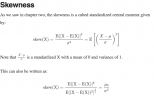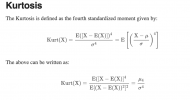Hi David,
Could you please provide some guidance on the following:
1) Sample Skewness and Kurtosis Formulas
I have seen 2 differnt versions,can you please clarify which is correct:
Version#1: Sample Skewness
Sum of Third moment about the mean / cube of Std Deviation * 1/ N
Version#2:
[ [ Sum of Third moment about the mean] / (n-1) ] / cube of Std Deviation
Which one is correct?
2) In Gujarati 3.8, can you please provide additional details concerning the use/purpose of the Alternative Skew and Kurtosis calculation that is provided.
Thank you
Could you please provide some guidance on the following:
1) Sample Skewness and Kurtosis Formulas
I have seen 2 differnt versions,can you please clarify which is correct:
Version#1: Sample Skewness
Sum of Third moment about the mean / cube of Std Deviation * 1/ N
Version#2:
[ [ Sum of Third moment about the mean] / (n-1) ] / cube of Std Deviation
Which one is correct?
2) In Gujarati 3.8, can you please provide additional details concerning the use/purpose of the Alternative Skew and Kurtosis calculation that is provided.
Thank you


